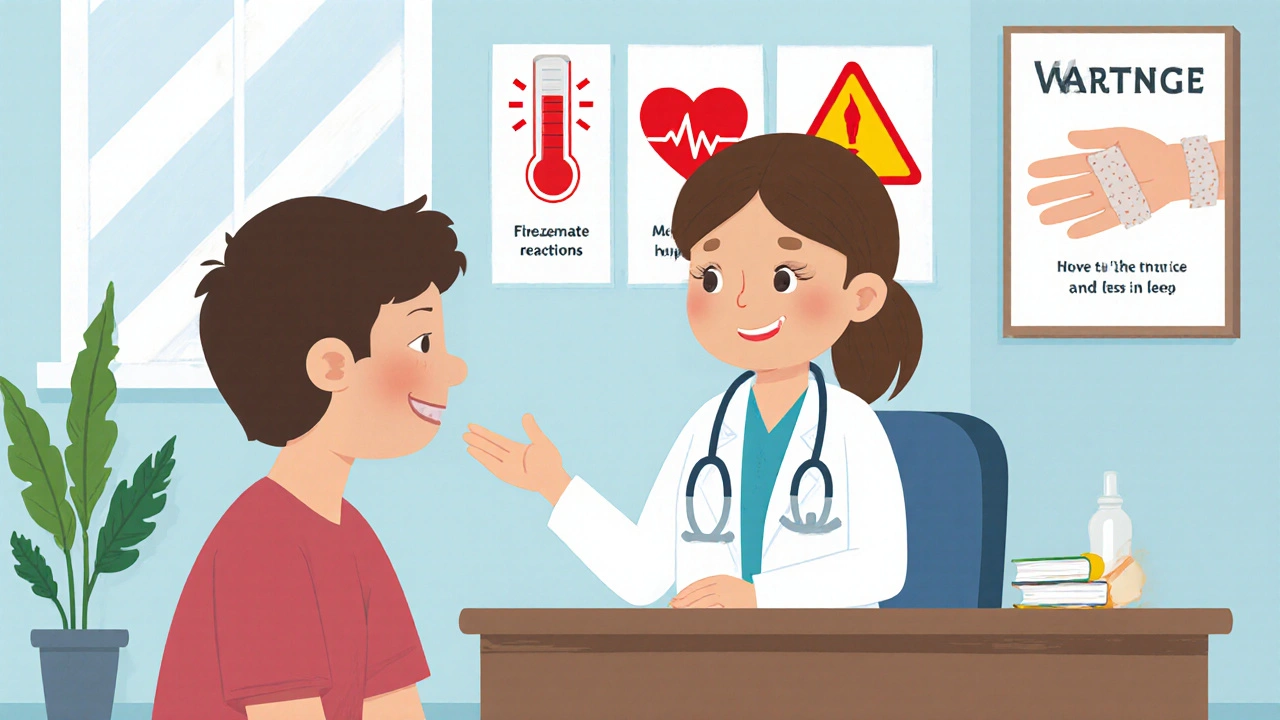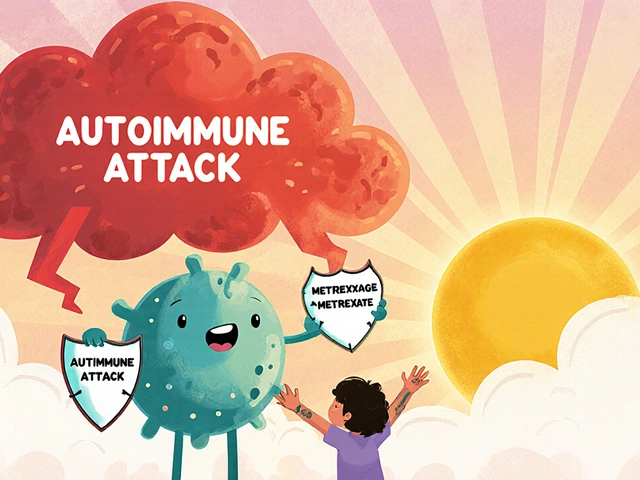Fluoxetine Side Effects Checker
Check Your Symptoms
Enter the symptoms you're experiencing. This tool provides general guidance only - always consult your healthcare provider for personalized medical advice.
Enter your symptoms to get personalized guidance.
You’ve probably heard that fluoxetine side effects can range from a mild headache to something more serious. Knowing exactly what to expect can turn anxiety into confidence, especially if you or a loved one just started the medication.
What is Fluoxetine?
Fluoxetine is a prescription drug sold under brand names such as Prozac. It belongs to the class of selective serotonin reuptake inhibitors (SSRIs), which are commonly used to lift mood and ease anxiety. First approved in 1987, it quickly became a go‑to option for doctors treating major depressive disorder, obsessive‑compulsive disorder, bulimia nervosa, and panic disorder.
How Does It Work?
Fluoxetine blocks the reabsorption (reuptake) of serotonin, a neurotransmitter that helps regulate mood, sleep, and appetite. By keeping more serotonin available in the brain, the drug can improve emotional stability over several weeks.
Who Typically Takes It?
- Adults diagnosed with major depressive disorder.
- Teenagers (13+) with obsessive‑compulsive disorder or bulimia.
- People with panic disorder or generalized anxiety.
- Sometimes prescribed off‑label for premenstrual dysphoric disorder.
Doses usually start at 20 mg per day and can be increased to 60 mg depending on response and tolerance.
The Most Common Side Effects
About one‑third of patients notice at least one of these effects within the first few weeks:
- Nausea or stomach upset.
- Insomnia or feeling unusually sleepy.
- Headache.
- Dry mouth.
- Loss of appetite leading to mild weight loss.
- Increased sweating.
These symptoms are often transient; they tend to fade as the body adjusts.
Less Common but Serious Reactions
While rare, some users experience side effects that need immediate medical attention:
- Serotonin syndrome - a potentially life‑threatening condition marked by high fever, rapid heartbeat, agitation, and muscle rigidity. It usually occurs when fluoxetine is combined with other serotonergic agents.
- Severe allergic reactions such as swelling of the face, lips, or throat.
- Suicidal thoughts, especially in adolescents and young adults during the early weeks of treatment.
- Bleeding abnormalities - fluoxetine can thin blood, increasing the risk of bruising or gastrointestinal bleeding when taken with NSAIDs or anticoagulants.
- Manic episodes in people with bipolar disorder.
Managing Side Effects
Most side effects can be mitigated with simple strategies:
- Take it with food - a light snack can reduce nausea and stomach discomfort.
- Set a consistent bedtime routine; avoiding caffeine after noon helps lessen insomnia.
- Stay hydrated; dry mouth often improves with increased fluid intake.
- If weight loss becomes a concern, discuss a slight dosage adjustment or a short‑term appetite stimulant with your doctor.
- For persistent headaches, over‑the‑counter acetaminophen (paracetamol) is usually safe, but check for drug interactions first.
Never stop the medication abruptly, as a sudden drop can trigger withdrawal symptoms like dizziness, electric‑shock sensations, or irritability. If you need to discontinue, taper the dose under medical supervision.
Key Drug Interactions
Fluoxetine is metabolised primarily by the liver enzyme CYP2D6. Substances that inhibit or induce this enzyme can alter fluoxetine levels:
- Inhibitors - certain antidepressants (e.g., paroxetine), antifungal agents (ketoconazole), and some antiretrovirals increase fluoxetine concentrations, raising the risk of side effects.
- Inducers - drugs like carbamazepine or St. John’s wort can lower fluoxetine levels, potentially reducing effectiveness.
- Combined use with other serotonergic medications (e.g., tramadol, triptans, or MAO inhibitors) heightens the chance of serotonin syndrome.
- Alcohol can worsen sedation and liver strain; moderation is advised.
Always share a complete medication list with your prescriber, including over‑the‑counter supplements.

When to Call a Doctor
Seek medical help promptly if you experience any of the following:
- Fever above 101 °F (38.3 °C) with rapid heartbeat.
- Severe or worsening nausea that leads to vomiting.
- Persistent insomnia that disrupts daily functioning.
- Sudden mood changes, especially increased aggression or suicidal thoughts.
- Unexplained bruising, nosebleeds, or black‑tinted stools.
These signs may indicate that the dosage needs adjustment or that an alternative treatment is safer.
Quick Reference Table
| Side Effect | Typical Frequency | Usual Management |
|---|---|---|
| Nausea | 10‑20 % | Take with food, split dose |
| Insomnia | 8‑15 % | Morning dosing, limit caffeine |
| Headache | 5‑12 % | Paracetamol, hydration |
| Dry mouth | 4‑10 % | Sugar‑free gum, water |
| Sexual dysfunction | 3‑7 % | Discuss dose timing or switch |
| Weight change | 2‑6 % | Diet review, monitor trend |
Frequently Asked Questions
How long does it take to feel the benefits of fluoxetine?
Most people notice a mood lift after 2‑4 weeks, but full therapeutic effects may need 6‑8 weeks. Patience and regular follow‑up are key.
Can I drink alcohol while on fluoxetine?
Occasional light drinking is generally okay, but heavy alcohol can worsen side effects and increase liver strain. Talk to your doctor about your drinking habits.
Is it safe to take fluoxetine during pregnancy?
The decision is complex. Some studies link early‑trimester exposure to a slight increase in birth defects, while untreated depression also poses risks. A doctor can weigh the pros and cons for each case.
What should I do if I miss a dose?
Take the missed pill as soon as you remember, unless it’s almost time for the next dose. In that case, skip the missed one and continue with your regular schedule. Do not double‑dose.
Why do some people feel more anxious when they start fluoxetine?
An initial surge in serotonin can temporarily heighten nervous system activity, causing jitteriness or anxiety. This usually settles within a week or two, but tell your clinician if it persists.






13 Comments
Hey folks, great rundown on fluoxetine! It's awesome to see the side‑effects laid out so clearly. If you're just starting, remember to take the pill with a light snack – it often eases the nausea. Stick to a regular sleep schedule and try to limit caffeine after noon; that can really help with the insomnia. And most importantly, give the medication a few weeks; many of those hiccups fade as your body adjusts.
Honestly this article is just a rehash of the standard brochure. It spells out the obvious – nausea, headaches, dry mouth – nothing new. The so‑called “management tips” are basic and sound like advice from a bored pharmacist. If you wanted real insight, you'd need to dig deeper than this superficial list.
While the encouragement is nice, some readers might need a heads‑up about the serious risks. Serotonin syndrome, though rare, can be life‑threatening if fluoxetine is mixed with other serotonergic drugs. Also, the article could stress more on the importance of monitoring mood changes in teens. A bit more nuance would make the guide truly comprehensive.
Fluoxetine shifts serotonin levels it can lift mood but also jitter the system sometimes
It’s a tradeoff worth watching especially early on
Patience and regular check‑ins with your doctor are key
Hey, I totally get how weird the stomach upset can feel, it’s like your tummy’s doing a rollercoaster. Definately try takin it with some food – a banana or toast works wonders. If the dry mouth keeps bugging u, sip water often and chew sugar‑free gum. And don’t stress too much, most side effects calm down after a couple weeks, just keep an eye on how you feel.
The pharmacological profile of fluoxetine necessitates a rigorous evaluation of both its therapeutic benefits and its adverse event spectrum.
The clinical trials have consistently reported a prevalence of minor adverse effects, yet the statistical incidence of severe complications warrants particular scrutiny.
Notably, serotonin syndrome emerges as a critical concern when fluoxetine is co‑administered with other serotonergic agents, a fact insufficiently emphasized in many lay‑person resources.
The pathophysiology involves excessive serotonergic stimulation of central and peripheral receptors, precipitating hyperthermia, autonomic instability, and neuromuscular aberrations.
In practice, clinicians should obtain a comprehensive medication history to preempt such iatrogenic interactions.
Moreover, the drug’s impact on platelet aggregation, mediated through serotonin depletion, raises the probability of hemorrhagic events, especially when combined with non‑steroidal anti‑inflammatory drugs.
The epidemiological data indicate a modest but measurable elevation in gastrointestinal bleeding risk under these conditions.
Another dimension of concern pertains to the psychiatric sequelae observed in adolescent populations, wherein emergent suicidal ideation has been documented within the initial treatment window.
Regulatory agencies have mandated black‑box warnings, yet the practical implementation of vigilant monitoring protocols remains inconsistent across clinical settings.
From a pharmacokinetic perspective, fluoxetine’s inhibition of CYP2D6 imposes a substantial interaction potential with substrates metabolized via this pathway, including certain antipsychotics and antiarrhythmics.
Consequently, dose adjustments or alternative therapeutic strategies may be requisite to mitigate toxicity.
The literature also reveals occasional reports of mood destabilization, manifesting as manic episodes in patients with latent bipolar disorder, underscoring the necessity of thorough diagnostic assessment prior to initiation.
While the drug’s efficacy in ameliorating depressive symptomatology is well‑established, a balanced risk‑benefit analysis must incorporate these multifaceted considerations.
Patients are advised to report any atypical sensations, such as electric‑shock‑like paresthesias, which may herald withdrawal phenomena upon abrupt discontinuation.
Tapering regimes, individualized to patient tolerance, constitute best practice to avert discontinuation syndrome.
Ultimately, informed consent, ongoing dialogue between prescriber and patient, and meticulous surveillance constitute the pillars of safe fluoxetine utilization.
Great summary! 😊 A few practical points to add: start with a low dose and titrate up slowly to reduce nausea, and consider a bedtime dosing schedule if insomnia persists. Monitoring blood pressure isn’t usually required, but keep an eye on any unusual bruising, especially if you’re also taking NSAIDs. If you notice any signs of serotonin syndrome, seek medical help immediately – it’s better to be safe than sorry. Lastly, maintain regular follow‑ups with your psychiatrist to adjust the dose as needed.
From a pharmacodynamic standpoint, fluoxetine operates as a high‑affinity serotonin reuptake inhibitor, resulting in synaptic serotonin potentiation. The resultant upregulation of post‑synaptic serotonergic receptors can modulate affective circuitry, albeit with a latency period reflective of neuroadaptive processes. Clinicians should therefore incorporate both pharmacokinetic half‑life considerations (≈4‑6 days) and potential cytochrome‑P450 interactions into their therapeutic algorithm.
Stopping fluoxetine cold is a disaster it can fling your brain into electric shocks and endless dread you deserve better than that
You got this!
One must contemplate the existential weight of chemically‑induced mood alteration the very notion of pharmacological euphoria borders on the sublime yet perilously treads the abyss of dependence
In addition to the points raised, I would recommend incorporating a structured patient education module that outlines symptom monitoring, dosage titration protocols, and emergency contact procedures. This systematic approach enhances adherence and facilitates early detection of adverse events, thereby optimizing therapeutic outcomes.
Fluoxetine is effective for depression; however, regular assessment for side effects is essential.